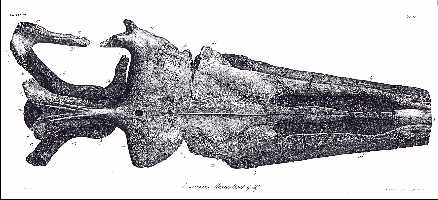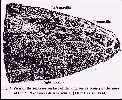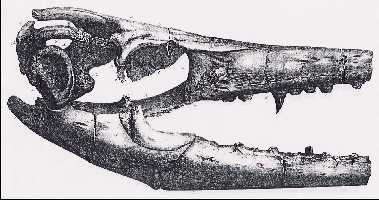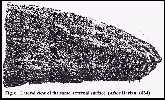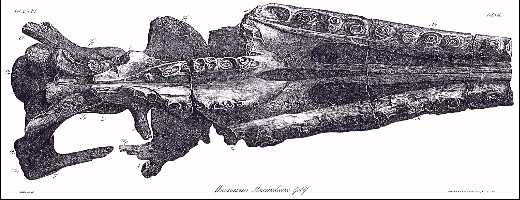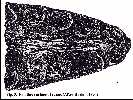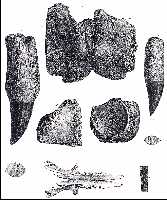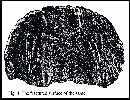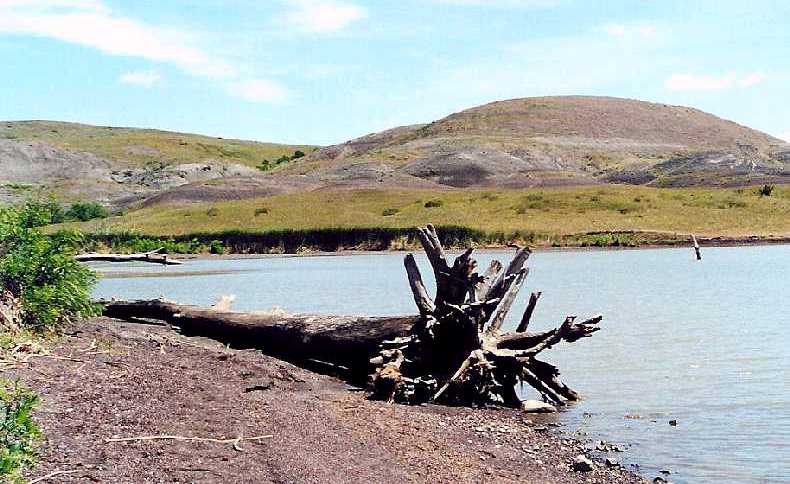 |
Mosasaurus
Maximiliani Goldfuss 1845:
An 1845 German
publication about one of the first mosasaur specimens from the American West, with an
interesting twist.
Copyright ©
2001-2013 by Mike
Everhart
Last updated
10/21/2013
Left: A view
of the shoreline of the "Big Bend" of the Missouri River in South Dakota, near
the place where the specimen was found nearly 170 years ago. NOTE:
The published version of this translation is: Goldfuss,
A. 2013. The
skull structure of the Mosasaurus, explained by means of a
description of a new species of this genus. Kansas Academy of Science,
Transactions 116(1-2):27-46 |
The first mention of mosasaurs from the American
West probably comes from the notes kept by the Lewis and Clark Expedition of
1804-1806. Sergeant Gass, who found a large skeleton in 1804, wrote in his
journal, published 1807: Monday, September 10th.
[1804] We had a foggy morning, but moved on early; pass high bluffs on the north side, and
saw some timber in the bottom on the south side. At 12 we came to black sulfur bluffs on
the south side. On the top of these bluffs, we found the skeleton or back bones of a fish,
45 feet long, and petrified. part of these bones were sent to the city of
Washington."
Samuel Mitchell (1818) also recounts the discovery
of a "petrified skeleton of a very large fish, seen in Sioux country, up the
Missouri, by Patrick Gass."
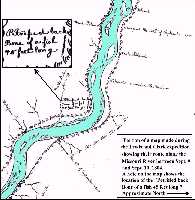 |
Harlan (1834) wrote: "It
is not improbable that Lewis and Clark, in their Expedition up the Missouri, allude to the
remains of a similar animal in the following extracts. "Monday, September 10th, 1804,
we reached an island (not far from the grand detour, between Shannon creek and Poncarrar
River), extending for two miles in the middle of the river, covered with red cedar, from
which it takes the name of Cedar Island; just below this island, on a hill, to the
south, is the back-bone of a fish forty-five feet long, tapering towards the tail, and
in a perfect state of petrifaction, fragments of which were collected and sent to
Washington." (Click on map at left) The remains subsequently were lost before they
were properly identified. While they were
probably the vertebrae of a large mosasaur, it is unlikely that we will ever know for
sure. Four members of the expedition wrote separate accounts of the discovery in
their journals. (See Moultin, 1983-1997, for entries of September 10, 1804; Read
Clark's Journal for September 10, 1804). This point on the river is several
miles below the confluence with the White River and is probably in the northwest corner of
present day Gregory County, South Dakota. |
Then, almost 30 years later, another mosasaur
fossil was found further north along the river. This second specimen was apparently
found by a fur trapper near the Big Bend of the Missouri River in what is now central
South Dakota in the early 1830s. The articulated skull, lower jaws and vertebrae were
brought back to St. Louis where it was acquired by an Indian Agent named Major
Benjamin O'Fallon and displayed in the formal garden of his home. The specimen
eventually came to the attention of Prince Maximilian zu Wied (1782-1867) during his
travels through the American West in 1832-1834 (see Maximilian-Bodmer
Expedition) and was purchased (?) by him. (Click here for more about Prince Maximilian zu
Wied-Neuwied; naturalist, ethnologist) In what must have been a major logistical
undertaking for the time, the fossil was then shipped from St. Louis to Germany and given
to Dr. August Goldfuss, a
naturalist in Bonn. Over a period of several years, Goldfuss meticulously prepared
and described the specimen, then named the mosasaur Mosasaurus Maximiliani
in honor of Prince Maximilian. His paper, "Der Schädelbau des Mosasaurus"
(The Structure of the Skull of Mosasaurus) was originally presented at a
scientific meeting in Mainz, Germany in the Fall of 1842 and then published in 1845.
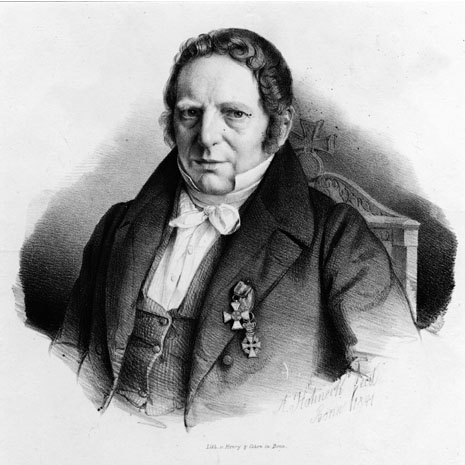 |
LEFT: Georg
August Goldfuß was born on April 18, 1782 in Thurnau (Franconia/Bavaria)
as son of Johann Georg Goldfuß (1748-1785), a court physician. He
attended the Latin school in Thurnau and started to study medicine, first
as student of a surgeon in Arzberg (Franconia/Bavaria) and from 1801-1803
at the Collegium medico-chirurgium in Berlin. Here his studies also
included zoology and natural history. In August 1804 Goldfuß moved to the
University of Erlangen where he acquired the title Doctor of Medicine and
Surgery with a thesis on South African beetles. He worked on the Natural
History collection of that University until 1806. In 1808 Goldfuß
accepted a position as a teacher at the home of Baron Winkler von
Mohrenfeld and had thoughts about an emigration to Calcutta (India). In
1810, however, he returned to the University of Erlangen and, on February
20, earned a position as a lecturer in Zoology and Geognostics. In 1815
Goldfuß married Eleonore Oelhafen (1789-1873) and in 1818 he became first
Professor for Natural History at the new Friedrich-Wilhelms-University in
Bonn. There he founded a Natural History Museum. Due to his connections to
collectors, the collections of the museum grew rapidly and by 1821 already
included 26635 inventoried items. Beginning in 1820, Goldfuß concentrated
on his Petrefacta Germaniae, an atlas of all fossils discovered in the
German speaking area and neighboring states in text and pictures (It was
published in 3 issues from 1826 – 1844). Due to medical problems, Goldfuß
could not continue his lectures after 1847 and on February 10, 1848, he
died on a stroke. He was buried in Poppelsdorf (now Bonn). Georg August
Goldfuß had six daughters and five sons, among them the Zoologist Otto
Goldfuß (1831-1905).
Source:
Björn
Thomann. Georg August Goldfuß (1782-1848), Zoologe und Geologe.
Landschaftsverand Rheinland. Portal Rheinische Geschichte
Figure
and translation generously provided by Sven Sachs, July, 2013.
|
[An electronic version of this paper (in German;
and in English) is available on request from Oceans of Kansas Paleontology. Click here for the English translation on the Web]
In the paper, Goldfuss writes: "Bereits bei der Versammlung der Naturforscher in unserer Stadt hatteich
die Ehre, der geologischen Section die, vom Gesteine umschlossenen, Bruchstücke eines
fossilen Skelettes vorzuzeigen, welche Se. Durchlaucht der Prinz Maximilian zu Wied
unserem Museum als ein höchst schätzbares Geschenk verehrt hatte." which roughly
translates to: "At the recent meeting of the geological section of natural scientists
in our city, I had the honor to present fragments of a fossil skeleton which the Prince
Maximilian of Wied had generously given to our museum as a most appreciated gift."
There were four figures published with the paper.
They are very large foldouts and are difficult to reproduce in a .jpg format. The
electronic versions shown below are "thumbnails" of the large scans (180 to 240
kb) of the original figures. The specimen is in storage with other fossils described by
Goldfuss in the Goldfuss
Museum (University of Bonn), Bonn, Germany. The work done by Goldfuss
(1845) was significant for the fact that it was the first time that an articulated,
undistorted mosasaur skull had ever been shown. The original Dutch skull (Mosasaurus
hoffmanni), figured by Cuvier, was mostly disarticulated. This more-or-less complete
skull from the American West really gave people their first idea of what the head of a
mosasaur actually looked like.
Cope (1875, p. 130) dismissed Goldfuss's contribution to the study of mosasaurs
with the following comment, "The knowledge of the structure of this order has
been due to the labors of three paleontologists, viz, Georges Cuvier, Prof. O. C. Marsh
and the writer. Cuvier determined the characters of the dentition, and of the anterior
regions of the skull, and of the vertebral column. Professor Goldfuss added little to this
beyond the description of the parieto-quadrate and postorbito-malar arches." Baur
(1892), however, said that, "... if this important paper had been studied more
carefully by subsequent writers, much confusion could have been spared. Williston
(1895) elaborated further on the subject when he said, "As Baur has said, had later
authorities studied this paper more attentively they would not have claimed as new a
number of discoveries made and published long before, among which may be mentioned the
position of the quadrate bone, the presence of the quadrato-parietal and malar arches, and
the sclerotic plates." [Editor's note: Here Williston refers to Marsh's (1872) claim
that he had discovered that mosasaurs were covered with dermal plates. These were
soon shown to be pieces of the bony scleral ring around the mosasaur eye]
Note that the end of the snout is missing from the
skull described by Goldfuss. The rest of the story may be just as interesting. A paper published by Dr. Richard Harlan in 1834 described and
named a new species of "Ichthyosaur" from fragments of the anterior end of a
mosasaur snout. Harlan gave it the name of Ichthyosaurus Missouriensis.
Goldfuss (1782-1848), a German naturalist, and Harlan (1796-1843), a Philadelphia surgeon
and naturalist, were contemporaries. Harlan also has the dubious distinction of
mis-identifying and mis-naming the early whale Basilosaurus
from a single vertebrae. He thought it was a Eocene plesiosaur. The name means
"King of the reptiles" (see Harlan's other 1834 paper
here). Basilosaurus was soon recognized by Sir Richard Owen and others
as a mammal.
According to Harlan (1835), "We are indebted
to Major N. A. Ware for the specimens, who obtained them at St. Louis, from a fur trader
or trapper, who, '..on his return home from the Rocky mountains observed in a rock the
skeleton of an alligator animal, about seventy feet in length; he broke off the point of
the jaw as it projected. He said that the head part appeared to be three or four feet
long.'" It soon became quite clear that the fragment was part of a mosasaur and not
an ichthyosaur as proposed by Harlan.
In a footnote, Harlan notes that "Baron
Braunsberg Maximillian (sic) de Wied, during his recent visit to Philadelphia, on his
return from the Rocky Mountains, informed me that he had obtained the fossil skeleton of a
saurian animal, fifteen feet in length, from the 'great bend' of the Missouri River, which
on comparison of its characters with those of the animal above [Harlan's Ichthyosaur]
noticed, he thinks belongs to the same species."
Not only were the remains from the same species as
described by Goldfuss more than 10 years later, it also appears quite likely that
Harlan's "ichthyosaur" fragment is the missing piece from the Goldfuss
mosasaur. Three of Harlan's published figures (1834) are shown below beside the
excellent figures of Goldfuss (1845). Hence, the regal name of Mosasaurus
Maximiliani Goldfuss 1845 became a junior synonym of Mosasaurus missouriensis (Harlan, 1834). Another
excellent example of this species (KUVP 1034) was initially thought to be a new species
and described under the name of Mosasaurus
horridus by Williston in 1898 .
I might add here that the 'mystery' of the missing
snout was solved long ago. According to Russell (1967), the missing piece could not
be located, but references an 1845 letter from Hermann von Meyer to "Professor
Bronn," published in the Neues Jahrbuch für Mineralogie,
Geognosie, Geologie und Petrefaktenkunde (pp.
308-313) with the first mention that Harlan's 'ichthyosaur' fragment being a part of the
Goldfuss mosasaur. Cope (1875) also noted in his literature listing on page 51 that
the Goldfuss material was possibly the "remaining part of Harlan's specimen."
Camp (1942) provides a more lengthy explanation.
Here's the note from Von Meyer (1945, p.
313): Die Schnautzen-Spitze, welche an dem vom Prinzen
Maximilian zu Wied mitgebrachten Schädel des Mosasaurus Maximiliani fehlt, lässt
sich so gut durch die von Harlan zuerst als Ichthyosaurus Missouriensis und dann
als Batrachiosaurus Missouriensis beschriebene Schnautzen-Spitze ergänzen, dass
man glauben sollte, sie rührte von demselben Individum her."
....
which roughly translated says: " “The end of
the snout, which is missing from the head of the Mosasaurus Maximiliani
acquired by Prince Maximilian of Wied, can be supplemented so well by the end of
the snout described by Harlan first as Ichthyosaurus Missouriensis and
then as Batrachiosaurus Missouriensis that one should believe, it was
from the same individual.”
The final chapter in the story of the missing
snout occurred in May, 2004 when Gorden Bell and Mike Caldwell were visiting the National
Museum of Natural History in Paris, France just before the First
Mosasaur Meeting in Maastricht. While in the process of examining mosasaur specimens
in the French collection, they came across an unusual, but familiar piece of bone. It was
the snout of "Ichthyosaurus" missouriensis
described by Harlan in 1834. Dr. Harlan had apparently sent his specimen to the museum in Paris where it was properly
catalogued and promptly forgotten. The museum provided a cast to Gorden and Mike, and
they in turn allowed me photograph the specimen. Then my friend Takehito Ikejiri visited
the Paris museum after the First Mosasaur Meeting and was able to photograph the original
specimen. Caldwell and Bell subsequently published a paper describing the original
discoveries and the re-location of the missing premaxilla (see below).
The following pictures of the original Mosasaurus missouriensis (=
M. Maximiliani) specimen prepared by Dr. August Goldfuss were provided by Oliver
Wings (Dinosaurhunter.org)
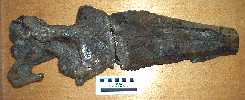
|
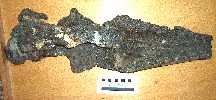
|
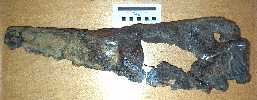
|
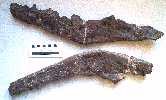
|
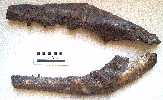
|
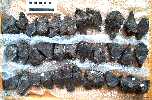
|
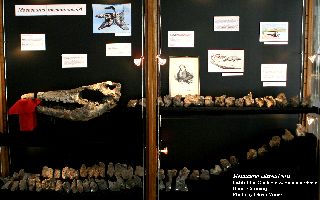
|
LEFT and RIGHT: The re-union between the snout (a cast) of
Harlan's Ichthyosaurus missouriensis and the skull of Mosasaurus "Maximiliana"
missouriensis Goldfuss 1845; a perfect fit. Photos provide by Oliver Wings, January, 2008. Used with
permission. |
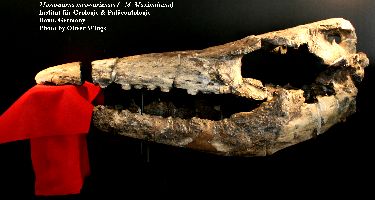
|
References (Click here to see my entire marine reptile references list):
Baur, G. 1892. On the morphology of the skull of the Mosasauridae,
Jour. Morphology, 7(1):1-22, 2 pl.
Caldwell, M.W., and Bell, G.L., Jr. 2005. Of German princes and North American
rivers: Harlan's lost mosasaur snout rediscovered. Netherlands Journal of Geosciences /
Geologie en Mijnbouw, 84(3), p. 207-211.
Camp, C.L. 1942. California Mosasaurs. University of California
Press, 67 p.
Cope, E.D. 1875. The vertebrata of the Cretaceous formations of
the West. Report, U. S. Geol. Surv. Terr. (Hayden). 2:302 p, 57 pls.
DeKay, J.E. 1830. On the remains of extinct reptiles of the
genera Mosasaurus and Geosaurus found in the secondary formation of New
Jersey; and on the
occurrence of a substance recently named coprolite by Dr. Buckland, in the same locality.
Annals of the Lyceum of Natural History of New York, 3:134-141. (Original
description of the type specimen of Mosasaurus dekayi Bronn, 1838)
Gass, P. 1807. A journal of the voyages and travels of a corps of
discovery, under the command of Capt. Lewis and Capt. Clarke of the Army of the United
States, from the mouth of the River Missouri through the interior parts of North America
to the Pacific Ocean, during the years 1804, 1806 and 1806. Printed by Zadok Cramer,
Pittsburg, for David McKeehan, Publisher and Proprietor, 262 pp.
Goldfuss, A. 1845. Der Schädelbau des Mosasaurus,
durch Beschreibung einer neuen Art dieser Gattung erläutert. Nova Acta Academa Ceasar
Leopoldino-Carolinae Germanicae Natura Curiosorum 21:1-28, pl. VI-IX.
Goldfuss, A. 2013. The skull structure of the Mosasaurus, explained
by means of a description of a new species of this genus. Kansas Academy of
Science, Transactions 116(1-2):27-46 (Translated from: Goldfuss, A. 1845. Der
Schädelbau des Mosasaurus, durch Beschreibung einer neuen Art dieser
Gattung erläutert. Nova Acta Academa Ceasar Leopoldino-Carolinae Germanicae
Natura Curiosorum 21:1-28.).
Harlan, R. 1834. Notice of fossil bones
found in the Tertiary formation of the State of Louisiana. Trans. Amer. Philos. Soc.
4:397-403, pl. XXX.
Harlan, R. 1834. Notice of the
discovery of the remains of the Ichthyosaurus in Missouri. N. A.. Trans.
Amer. Philos. Soc. 4:405-409, pl. XXX.
Harlan, R. 1835. Critical notices of various organic remains
hitherto discovered in North America. Trans. Geol. Soc. of Pennsylvania i, pt. i pp.
46-112, Philadelphia. (pages 76-81 only)
Harlan,
R. 1839. Notice of the discovery of Basilosaurus and Batrachotherium.
Proceedings of the Geological Society of
London
3:23-24.
Marsh, O.C. 1872. Discovery of the dermal scutes of mosasaurid
reptiles; Amer. Jour. Sci. ser. 3, 16:290-292.
Mitchell, S.L. 1818. Observations on the geology of North
America, illustrated by the description of various organic remains found in that part of
the world. Pages 319-431, pls. 6-8. In Cuvier, G., Essay on the theory of the
earth, New York, Kirk and Mercein, xxiii + 431 p. 8 pls.
Moultin, G.E. (ed.), 1983-1997. The journals of the Lewis and Clark
Expedition. Vol. 1-11. Univ. Nebraska Press, Lincoln and London.
Russell, D.A. 1967. Systematics and morphology of American
mosasaurs. Peabody Museum of Natural History, Yale University, Bulletin 23.
Von
Meyer, H. 1845. (Letter to Professor Bronn). Neues Jahrbuch für Mineralogie,
Geognosie und Geologie 1845:308-313
Williston, S.W. 1895. New or little-known extinct vertebrates.
Kansas Univ. Quar.3(3):165-176.
Williston, S.W. 1898. Mosasaurs. The University Geological Survey
of Kansas, Volume IV, Paleontology, Part V, pp. 81-347.
Credits: A special thank you to Earl Manning for copies of his
early mosasaur references and his assistance in creating this page. Also I greatly
appreciate the photographs of this specimen provided by Oliver Wings. I am indebted to Dr.
Robert T. Firestone (ret.), University of Colorado in Boulder, CO (Dept. of Germanic and
Slavic Languages) for his translation of Goldfuss (1845).




